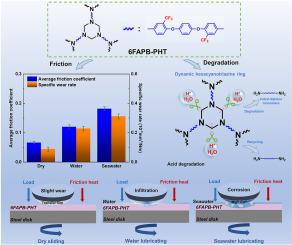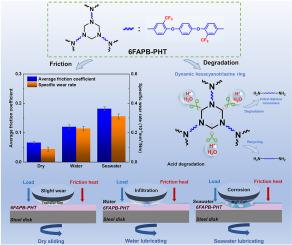Constructing the fluorine-containing structures for excellent tribological properties of degradable Poly(hexahydrotriazine)s
IF 4.5
2区 化学
Q2 POLYMER SCIENCE
引用次数: 0
Abstract
Nowadays, degradable thermosets are confronted with a contradiction between their low performance and practical applications. In light of the weak covalent bonding of reversible bonds in biodegradable thermosetting resins, limits their applications in the field of tribology. Herein, we synthesize degradable poly(hexahydrotriazine)s (PHTs) by introducing trifluoromethyl (-CF3) groups at different positions of the aromatic diamine main chains, achieving simultaneous improvement of degradability and high friction performance. The results showed that the fluorinated PHTs exhibited higher glass transition temperature (173.8 °C), tensile strength (61.8 MPa), and faster degradation rate (3 h) as compared to non-fluorinated polymer. Notably, fluorinated PHT resins exhibited excellent anti-wear performance with wear rates decreasing by 78.6 % owing to the large steric hindrance effect and strong electronegativity brought about by –CF3, which increases the rigidity and heat resistance of the PHTs molecules, thereby enabling it to effectively resist frictional heat generated during the friction process. Fluorinated PHTs revealed excellent wear resistance and degradation properties, which facilitates their practical application of energy conservation and protective metal anti-wear coatings in the tribological industry.


可降解聚六氢三嗪具有优异摩擦学性能的含氟结构的构建
目前,可降解热固性材料面临着性能低下与实际应用的矛盾。由于可生物降解热固性树脂可逆键的共价键弱,限制了其在摩擦学领域的应用。本文通过在芳香族二胺主链的不同位置引入三氟甲基(-CF3)基团,合成了可降解的聚六氢三嗪(PHTs),同时提高了可降解性和高摩擦性能。结果表明,与非氟化聚合物相比,氟化pht具有更高的玻璃化转变温度(173.8℃)、抗拉强度(61.8 MPa)和更快的降解速度(3 h)。值得注意的是,氟化PHT树脂表现出优异的抗磨性能,磨损率下降了78.6%,这是由于-CF3带来的较大的位阻效应和较强的电负性,增加了PHT分子的刚度和耐热性,从而有效地抵抗摩擦过程中产生的摩擦热。氟化pht表现出优异的耐磨性和降解性能,有利于其在摩擦学领域节能和保护金属抗磨涂层的实际应用。
本文章由计算机程序翻译,如有差异,请以英文原文为准。
求助全文
约1分钟内获得全文
求助全文
来源期刊

Polymer
化学-高分子科学
CiteScore
7.90
自引率
8.70%
发文量
959
审稿时长
32 days
期刊介绍:
Polymer is an interdisciplinary journal dedicated to publishing innovative and significant advances in Polymer Physics, Chemistry and Technology. We welcome submissions on polymer hybrids, nanocomposites, characterisation and self-assembly. Polymer also publishes work on the technological application of polymers in energy and optoelectronics.
The main scope is covered but not limited to the following core areas:
Polymer Materials
Nanocomposites and hybrid nanomaterials
Polymer blends, films, fibres, networks and porous materials
Physical Characterization
Characterisation, modelling and simulation* of molecular and materials properties in bulk, solution, and thin films
Polymer Engineering
Advanced multiscale processing methods
Polymer Synthesis, Modification and Self-assembly
Including designer polymer architectures, mechanisms and kinetics, and supramolecular polymerization
Technological Applications
Polymers for energy generation and storage
Polymer membranes for separation technology
Polymers for opto- and microelectronics.
 求助内容:
求助内容: 应助结果提醒方式:
应助结果提醒方式:


